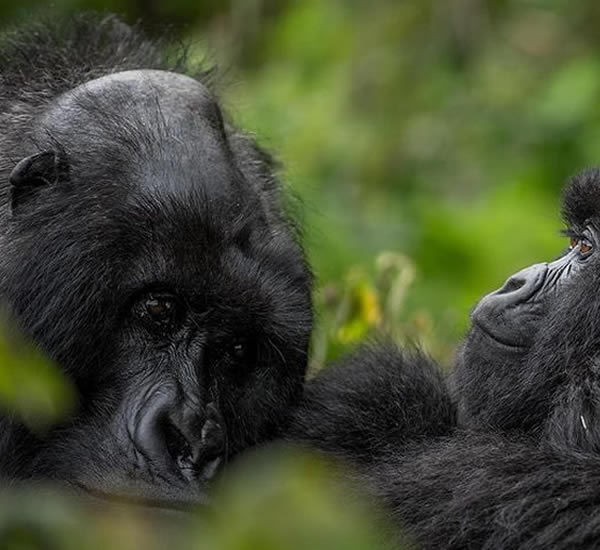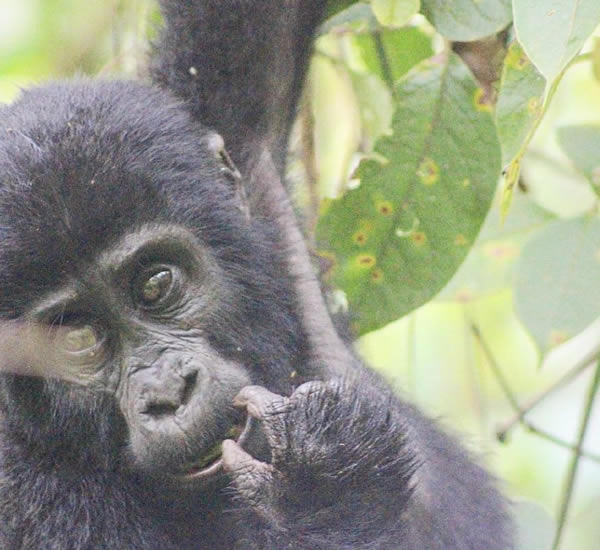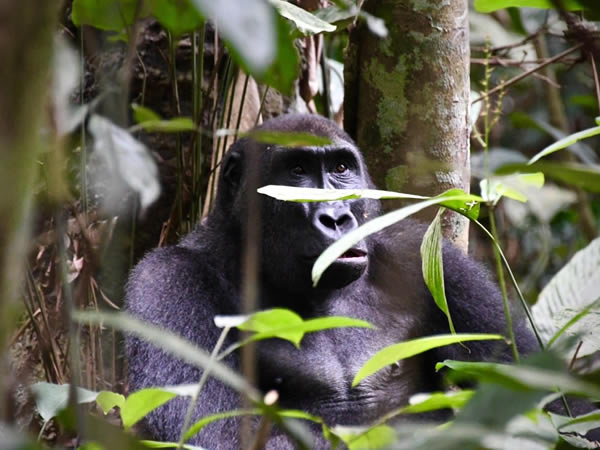With only approximately 1050 mountain gorillas left in the whole world, it is a once in a lifetime opportunity to see such a rare species. These endangered primates share over 98% of human DNA and have similar characters like humans. It can be a tough decision to decide where exactly to carry out your gorilla trek from. The insecurities in Congo has scared away so many trekkers even till now that Virunga is much stable.
 SAFARI PLANNING - Travel Info
SAFARI PLANNING - Travel Info
 GORILLA TREKKING GUIDE
GORILLA TREKKING GUIDE
 Where to Find Gorillas
Where to Find Gorillas
Gorilla trekking is a thrilling and immersive wildlife experience that allows visitors to observe endangered mountain gorillas in their natural habitat. Here’s everything you need to know about gorilla trekking:
What is Gorilla Trekking?
Gorilla trekking is an eco-tourism activity that involves hiking through dense forests in search of habituated groups of mountain gorillas, with the goal of observing them in their natural habitat. It offers a unique and immersive wildlife experience that allows visitors to connect with one of the world’s most endangered species while supporting conservation efforts and local communities.
During a gorilla trek, visitors are accompanied by experienced guides and trackers who lead them to gorilla families. Once the gorillas are located, visitors have a limited time to observe and photograph the gentle giants while maintaining a safe distance to minimize any potential threat on the wellbeing of gorillas and their environment. Gorilla trekking not only provides an unforgettable wildlife experience but also contributes to the conservation of these endangered species by generating revenue for conservation efforts and raising awareness about the importance of protecting their natural habitats.
What is Gorilla Habituation?
Gorilla habituation is a process whereby wild mountain gorillas are gradually acclimated to the presence of humans for the purpose of tourism and research. It involves a team of researchers and trackers spending extended periods of time near a specific gorilla group, slowly habituating them to the presence of humans through non-intrusive observation and minimal interaction. This process can take several years and requires patience, respect for the gorillas’ natural behaviour, and strict adherence to conservation guidelines.
Once habituated, the gorilla group may be opened to limited tourism activities, such as the Gorilla Habituation Experience (GHE), where visitors can spend an extended period of time observing and learning about the gorillas in their natural habitat under the guidance of experienced trackers and researchers. Gorilla habituation plays a crucial role in promoting conservation awareness, generating revenue for conservation efforts, and supporting local communities living near gorilla habitats.
Where is Gorilla Trekking done from in East Africa?
Gorilla trekking is primarily done in three countries in East Africa: Uganda, Rwanda, and the Democratic Republic of Congo (DRC). Each of these countries is home to populations of endangered mountain gorillas and offers unique gorilla trekking experiences. Here’s where gorilla trekking is done from in each of these countries:
Uganda: Bwindi Impenetrable National Park: Located in southwestern Uganda, Bwindi Impenetrable National Park is one of the most renowned gorilla trekking destinations in the world. It is home to about half of the world’s mountain gorilla population.
Mgahinga Gorilla National Park: Situated in the Virunga Mountains, Mgahinga Gorilla National Park is another gorilla trekking destination in Uganda. It shares borders with Rwanda and the DRC and is part of the larger Virunga Conservation Area.
Rwanda: Volcanoes National Park: Located in the Virunga Mountains in northern Rwanda, Volcanoes National Park is famous for its mountain gorilla population and gorilla trekking experiences. It was the site of Dian Fossey’s pioneering research on mountain gorillas.
Democratic Republic of Congo (DRC): Virunga National Park: Virunga National Park, situated in the eastern part of the DRC, is Africa’s oldest national park and is home to a significant population of mountain gorillas. Gorilla trekking experiences are offered within the park, although access may be subject to security considerations due to the region’s volatile political situation.
Kahuzi-Biega National Park: Located in the eastern DRC, Kahuzi-Biega National Park is another gorilla trekking destination. It is known for its eastern lowland gorillas, a subspecies of gorilla distinct from the mountain gorillas found in the Virunga Mountains.
How is Gorilla Trekking Done?
Gorilla trekking involves a carefully managed process of hiking through dense forests in search of habituated groups of mountain gorillas. Visitors typically start by obtaining permits from national park authorities in countries like Uganda, Rwanda, or the Democratic Republic of Congo. Upon arrival at the designated meeting point, visitors receive a briefing from park rangers and guides regarding safety guidelines, gorilla behaviour, and trekking etiquette. Visitors are then divided into small groups, each accompanied by experienced guides and armed rangers, and embark on a hike into the forest. Park rangers and guides use their knowledge of the gorillas’ habitat to track the location of habituated gorilla groups, a process that can take varying amounts of time. Once the gorilla group is located, visitors are allowed a limited time to observe and photograph the gorillas from a safe distance. Gorilla trekking supports
When is the best time for gorilla trekking?
The best time for gorilla trekking is during the dry seasons, typically from June to September and December to February, in East Africa. During these months, the weather is generally more stable, with less rainfall and more comfortable hiking conditions. However, gorilla trekking can be undertaken throughout the year, and each season offers unique experiences. The rainy seasons, from March to May and from October to November, may have lower visitor numbers and lush vegetation but can also involve hiking in muddy conditions. Ultimately, the best time for gorilla trekking depends on personal preferences, budget, and availability.
Why go Gorilla Trekking?
- Once-in-a-Lifetime Experience: Gorilla trekking offers a rare opportunity to observe endangered mountain gorillas in their natural habitat, providing a unique and unforgettable wildlife experience.
- Personal Connection: Gorilla trekking fosters a deeper connection with nature and wildlife, allowing visitors to witness the intricate social dynamics and behaviour of gorilla families firsthand.
- Adventure and Exploration: Gorilla trekking involves hiking through rugged terrain and dense forests, offering an adventurous and immersive outdoor experience for nature enthusiasts and adventure seekers.
- Educational Value: Gorilla trekking provides an educational opportunity to learn about gorilla conservation, habitat protection, and the importance of biodiversity conservation in fragile ecosystems.
- Photographic Opportunities: Gorilla trekking offers incredible photographic opportunities to capture stunning images of gorillas in their natural environment, creating lasting memories of the experience.
What to expect in gorilla trekking?
In gorilla trekking, visitors can expect an immersive adventure through dense forests in search of habituated mountain gorilla groups. The experience involves hiking, guided by experienced rangers and guides, to find the gorillas. Once located, visitors can observe the gorillas from a safe distance for a limited time, usually an hour, while learning about their behaviour and habitat. Expect to witness the gorillas’ social interactions, grooming rituals, and perhaps even playful behaviour. Gorilla trekking supports conservation efforts and local communities, offering a unique opportunity to connect with one of the world’s most endangered species while contributing to their protection and survival.

